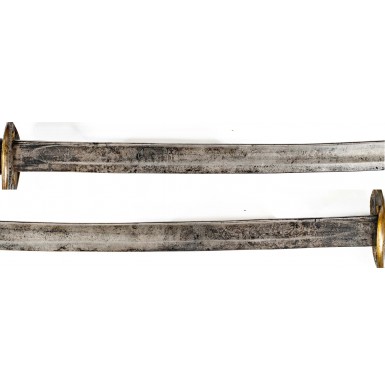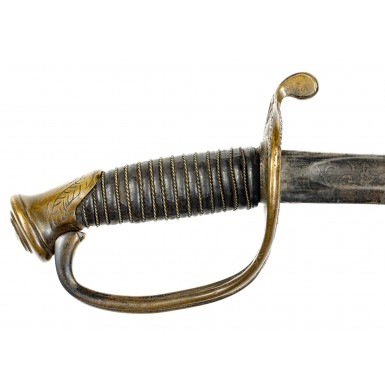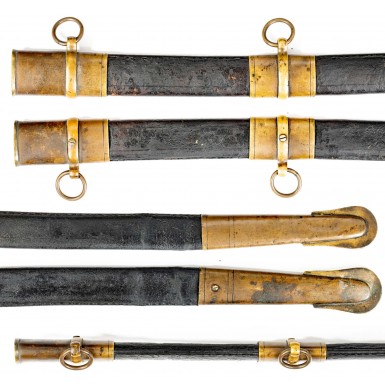Confederate Leech & Rigdon Style Confederate Foot Officer’s Sword Attributed to Louis Bissonnet
- Product Code: EWSK-1601-SOLD
- Availability: Out Of Stock
-
$1.00
For collectors of swords from the American Civil War, few are more desirable than those Confederate produced specimens that bear the letters “CS” or “CSA”. However, despite the research that has gone into the subject of Confederate swords during the last 60-plus years, no really good current reference book on the subject is available. The most thorough treatment of the subject is certainly William A. Albaugh III’s 1960 work Confederate Edged Weapons, with his additional 1963 work A Photographic Supplement of Confederate Swords enhancing and updating his earlier work that was limited to line drawing illustrations. However, other than a few specialty books like Louis Froelich Arms - Maker to the Confederacy by John McAden Jr. & Chris Fonvielle Jr., which looks specifically at the output of Froelich’s Confederate States Armory in North Carolina, little new information has been made readily available to collectors of Confederate swords. This dearth of readily available information has led to discussions and disagreements among collectors and students of Confederate-made swords as to the correct nomenclature and attribution of some swords that have been identified to certain makers since Albaugh’s groundbreaking work was published in 1960. The lack of newly published material is to be somewhat understood, as the modern researcher relies heavily upon access to original period documents to substantiate any conclusions that are drawn. As Confederate documents are often difficult to locate or simply did survive the war, this can present a problem in substantiating a theory that challenges the conventional wisdom established by the collectors of the 1950s and 1960s. However, in other cases, important documents are found in the research of related subjects that sometimes shed light on other parts of the story of Confederate arms contractors.
This prologue is necessary to begin the description of this wonderful Confederate Foot Officer’s Sword. For years, anyone with a passing knowledge of Confederate swords would immediately identify the piece a product of Thomas Leech & Charles Rigdon’s Memphis Novelty Works, sometimes simply known as Novelty Works or more simply Leech & Rigdon. The sword’s sandcast guard is emblazoned with a cast CS in an oval on the reverse of the counterguard. As maker marked examples of these swords exist, the swords of this pattern have been identified as the product of these two partners. However, unmarked examples of these sword exist as well, which have etched blade patterns that are attributed to Louis Bissonnet (sometimes Bissonnette) who worked in Mobile, AL circa 1861-1863. A handful of Bissonnet’s swords are known that are signed L Bissonnet and that bear a floral etched pattern that is of the same style found on some of the unsigned “Leech & Rigdon” foot officer’s swords like the one offered here. Thus, the most current belief is that the Leech & Rigdon foot officer swords of this pattern with Bissonnet pattern engraving should more accurately be called Louis Bissonnet swords, rather than Leech & Rigdon swords. In an attempt to make everyone happy, I have chosen to refer to this as a Leech & Rigdon Style Confederate Foot Officer’s Sword Attributed to Louis Bissonnet.
Thomas Leech was a pre-Civil War Memphis entrepreneur who was listed as a Cotton Broker at 35 Front Row in 1857. By 1859, Leech was also listed as a Gun Dealer, with an additional location on Elliott Street in Memphis. After the outbreak of the Civil War, Thomas Leech & Company contracted with the Confederate Ordnance Department in Memphis to produce a wide variety of military wares, including several patterns of swords, saber bayonets, accouterments and horse equipment. In late 1861 or early 1862, Leech partnered with Charles H. Rigdon of St. Louis to become Leech & Rigdon. Rigdon was a machinist and scale maker, and no doubt brought a level of complex manufacturing to the firm that was not previously possible. It was at this time the that firm began to offer their brass framed copy of the Colt Model 1851 Navy revolver to the Confederacy. During the course of the war, some 1,500 Leech & Rigdon revolvers would be produced by the firm.
As the reversals for the Confederacy in the Western Theater during the winter and spring of 1862 continued, plans to relocate the Leech & Rigdon production facilities to a safer location were made. By May of 1862, the company was advertising that it was up and running in Columbus, MS where the Confederate Briarfield Arsenal was located. The following month, the city of Memphis was under Union control after a brief naval battel on June 6. Late in 1862, Leech & Rigdon again sought to relocate to a safer area and moved to Greensboro, GA. During the relocation from Memphis to Columbus, it appears that much of the unfinished parts in inventory at Leech & Rigdon was transferred to the Briarfield Arsenal. These parts apparently included everything from sword and bayonet blades and “handles for same” to scabbards and possibly some raw materials. The blades were apparently in various stages of completion. A May 15, 1862 invoice from the Briarfield Arsenal listed the sale of many of these parts to Cook & Brother and includes such items as “half-finished bayonets”, “rough cutlass blades” and “artillery saber blades” as well as some raw materials. The fact that the Briarfield Arsenal was selling both finished and unfinished parts as well as raw materials to a contractor like Cook & Brother gives some insight into the way in which the Confederate Ordnance system did the best it could with available resources. It also provides a potential explanation for swords like the one offered here. Perhaps Briarfield, or Leech & Rigdon themselves were selling sword components or even finished swords to people like Louis Bissonnet.
Louis Bissonnet was born in France circa 1837 and according to the 1860 Census was living in Hardin, TX and working as a jeweler. He was noted as having an estate valued at $350 and a personal estate of $1,000. He was living with his wife Merced (35) and his two children Catharine, a three year old listed as male and his five-month old daughter Odeal. Interestingly, the Census noted that Catharine was born in Alabama, indicating the family was living there circa 1857. By sometime in late 1861 or early 1862 Bissonnet had relocated to Mobile, where he was offering officer’s swords for sale. At the time of Albaugh’s Confederate Edged Weapons, only a Cavalry Officer’s Saber was known. Since that time other examples (including foot and staff officer swords) have been noted, some signed and some not. As Bissonnet appears to have been a jeweler and etcher, rather than a cutler, it seems likely that he was buying parts and assembling them, or maybe even acquiring complete swords. He might have relied upon Mobile sword maker James Conning to provide some completed swords, or to assemble parts that Bissonnet acquired elsewhere. It is also possible that Bissonnet purchased the cast hilts from sources like Leech & Rigdon and had them mounted on blades by Conning. In any case, it seems quite likely that Bissonnet was only the decorator, etcher, retailer and possibly the assembler of the swords that bear his name, but not the actual manufacturer.
The Leech & Rigdon Style Confederate Foot Officer’s Sword Attributed to Louis Bissonnet offered here is in VERY GOOD condition. The sword is a typical southern made copy of a US Model 1850 Foot Officer’s Sword, which was itself based upon the French Pattern 1845 officer’s sword. The sword measures 34 3/16” in overall length with a nominally 29” blade that measures 28 11/16”. The single edged, spear point blade is slightly curved and has a 24 ¼” unstopped fuller that measures about 5/8” wide at the widest point. The blade is nominally 1 1/16” wide at the ricasso and measures .35” thick at the spine in this location. The spine is slightly flat for about 2 ¾” from the ricasso towards the hilt and becomes rounder at that point until the blade tapers to a false edge about 21” from the hilt. The blade shows about 9” of etched floral decoration originating from the hilt toward the tip, of the pattern associated with Bissonnet’s work. There is no apparent presentation or maker mark in the etching, but the decoration is worn and sometimes difficult to see. The sand cast hilt has pierced floral motifs in the guard and a raised cast CS that measure about 1” wide on the reverse of the counterguard. The oval CS is flanked by a pair of laurel sprays and the pommel is cast with acanthus leaves and topped with an oval pommel cap. The knucklebow is plain and quality of the detail in the casting quite good, with sharp details. Later period “Leech & Rigdon” hilts often show sloppier casting with less clear details. Although crisply detailed, the hilt clearly shows the roughness expected of sand cast brass. The grooved wooden grip is covered in brown leather seamed along the bottom of the grip and has fifteen wraps of twisted brass wire wrapped around the cover. An oval white buff throat washer with a scalloped edge is in place on the face of the guard at the blade junction. The sword is contained in a top-seamed black leather scabbard with cast brass mounts that include a pair of soldered brass suspension rings. The rings measure nominally 1.3” on their exteriors and 1” on their interiors. The mounts are plain and simple with only incised lines for decoration and are secured by tension screws on their reverse.
As noted, the sword is in about VERY GOOD condition. The blade has been lightly cleaned and has a medium pewter patina with areas of brightness as well as scattered surface oxidation and discoloration. The darkest and most discolored areas on the obverse of the blade are the first 2”-3” near the hilt with patches of discoloration mottling the blade from about the middle of the blade to the tip. The reverse of the blade shows slightly less discoloration. Due to the reflectivity of the steel blade and the photographic lights, it was difficult to accurately capture the appearance of the blade. The resulting photos either make the blade appears brighter than it really is or that the discoloration and thicker and darker than it is. In reality the color is a medium steel patina, with the oxidation being darker gray to blackish, but not quite a thick as the images make it appear. The etching remains about 50%-60% visible, with areas that are more visible than others due to wear and cleaning. Depending upon the angle at which the sword is viewed, the etching is more or less visible, which has made it very hard to depict accurately in the photographs. The hilt has a wonderfully untouched, thickly oxidized rich bronze patina that would be equally at home on a fine Tiffany lamp. The hilt to blade junction remains tight and secure and the deeply oxidized tang peen is undisturbed. The leather grip covering appears to be original, as does the wire wrap, which does have a couple of areas of minor looseness. The wrap shows some scattered wear, flaking and finish loss, but remains in very nice condition. The white buff leather throat washer appears original as well and shows wonderful age and discoloration to a dull grayish-yellow color. The leather scabbard appears original to the sword and fits it wonderfully. It certainly appears to be of southern manufacture but is certainly not the type of scabbard associated with Leech & Rigdon swords, again suggesting the Bissonnet attribution. The scabbard remains relatively solid but like nearly every leather Confederate scabbard shows some restorative work, some strengthening of weakened areas and some added finish. The brass mounts have a wonderful rich, uncleaned patina like that of the hilt. The throat and middle mount are certainly original to the scabbard. The drag matches perfectly in terms of patina and styling but might be a very old replacement. It does not detract in any way but is mentioned for exactness as I would rather under describe an item than over hype it.
Overall this is a really wonderful Confederate Leech & Rigdon Style Confederate Foot Officer’s Sword Attributed to Louis Bissonnet in lovely condition. The sword is complete and correct and very attractive with the exceptionally desirable raised, cast CS in an oval in the reverse of the counterguard. The accompanying scabbard is a classic “corn pone” southern scabbard (as some other dealers in Civil War items would call it) and compliments the sword perfectly. The sword comes from a substantial collection of fine Civil War arms from Atlanta area and was purchased by the former owner from Steve Mullinax some thirty years ago. I am quite sure you will be very happy adding this fine Confederate Foot Officer’s Sword to your collection to treasure for the next 30 years or longer.
SOLD
Tags: Confederate, Leech, &, Rigdon, Style, Confederate, Foot, Officer’s, Sword, Attributed, to, Louis, Bissonnet

















